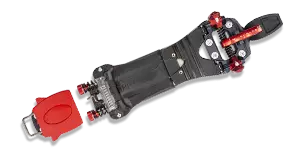Ski touring is a demanding activity that requires quality equipment to be practiced safely. If you're new to the sport, it can be difficult to know which accessories are essential for a successful day on the slopes.
In this article, we will outline the basic equipment you should consider to get the most out of your ski touring experience. Some items are similar to other outdoor sports and some are specific to this sport.
Seal skins
Sealskins are usually made of nylon or mohair, which is a softer and more slippery material than nylon. Mohair skins are more effective for long hikes and gentle slopes, while nylon skins are more durable and suitable for steep and icy terrain. It is important to ensure that the skins are the right size for your skis and that they are properly fitted before you set out on a tour. It is also advisable to bring a pair of scissors to cut the skins if necessary.

The avalanche transceiver + shovel + probe pack
The avalanche transceiver (DVA) is a compulsory safety device, and crucial for locating people buried in avalanches.
Before every outing in the mountains, it's important to check that your avalanche transceiver is working properly. Follow the manufacturer's instructions to carry out the necessary checks.
You should also carry a shovel and probe in your rucksack for digging and locating a buried person in the event of an avalanche.
Make sure you know mountain safety techniques, are aware of weather and avalanche conditions, and have the necessary equipment for safe ski touring. If you have specific questions about what equipment to take, it may be useful to consult a professional or a mountain guide.
A first-aid kit
A first-aid kit is an essential piece of equipment to take with you on your touring adventures. In the event of a medical emergency or injury, a basic first-aid kit can help you treat the injury until you can get professional help. Your first-aid kit should include items such as bandages, gauze, painkillers, disinfectants, dressings and scissors.
Depending on the length and nature of your trip, you may also want to add specific items, such as survival blankets, sterile gloves, hot/cold compresses, safety pins, an isothermal blanket or a tourniquet. It's also important to know how to use these items to treat injuries. Take the time to learn basic first-aid skills before your trip, so that you're well prepared in the event of an emergency.
Ski poles
Ski touring poles are specially designed in aluminium or carbon for this activity, which makes them lighter and stronger than traditional steel ski poles. They also have wider washers for better grip in deep snow and on steep slopes. Ski touring poles are also height adjustable, making them ideal for all sizes and slopes.
Ski touring boots
Ski touring boots are lighter and more flexible than traditional ski boots. They are designed for both uphill and downhill use, offering a good balance between the flexibility needed for ascent and the stiffness required for descent. It is important to choose boots that fit your feet perfectly to avoid pain and injury.
The Meidjo binding is an innovative ski touring binding that offers greater flexibility and freedom of movement than traditional alpine ski bindings. It is also lighter than alpine ski bindings, making it ideal for ski touring. The Meidjo binding features efficient power transmission, durability and a safety system. It is compatible with specific ski touring telemark boots, providing a smooth and comfortable ski touring experience.

A backpack
A backpack is essential for carrying your equipment and supplies. You'll need a bag big enough to hold everything you need for a day on the mountain, including water, food, a change of clothes and safety gear. Ski touring backpacks are usually equipped with straps to secure skis and poles when not in use.
Ski goggles
Ski goggles are essential to protect your eyes from UV rays, snow and strong winds. They also allow you to see obstacles on the piste more clearly. Ski goggles should be comfortable and fit snugly around your face to prevent slippage and cold air from entering. Polarised lenses are also a good option to reduce glare on the snow.
Discover Inwild straps: https://inwildoutdoor.com/en/products/accessoiries/black-strap
A hat or balaclava
A balaclava or hat is necessary to protect your head and ears from the cold. Bonnets can also be worn under a helmet for extra protection.
Ski gloves
Ski gloves are essential to keep your hands warm and dry while skiing. They should fit snugly for a better grip on the ski poles. Waterproof and breathable ski gloves are best to keep out moisture.
A camping stove
If you plan to take a break to eat or drink something hot, a camping stove can be very handy. It will allow you to heat water for tea, coffee or instant soups. Make sure you also bring a suitable fuel for your stove.

Make sure you choose the equipment that best suits your needs and skill level to get the most out of your ski touring experience. Also remember that safety should always be your priority, so make sure you have the necessary safety equipment, such as an avalanche beacon, shovel and probe.
In short, if you are new to the world of ski touring, you should get these essential accessories for a successful experience on the slopes. However, it is important to note that the list may vary depending on the destination and the weather conditions. It is therefore advisable to consult with mountain professionals for a complete and detailed list of equipment required.






